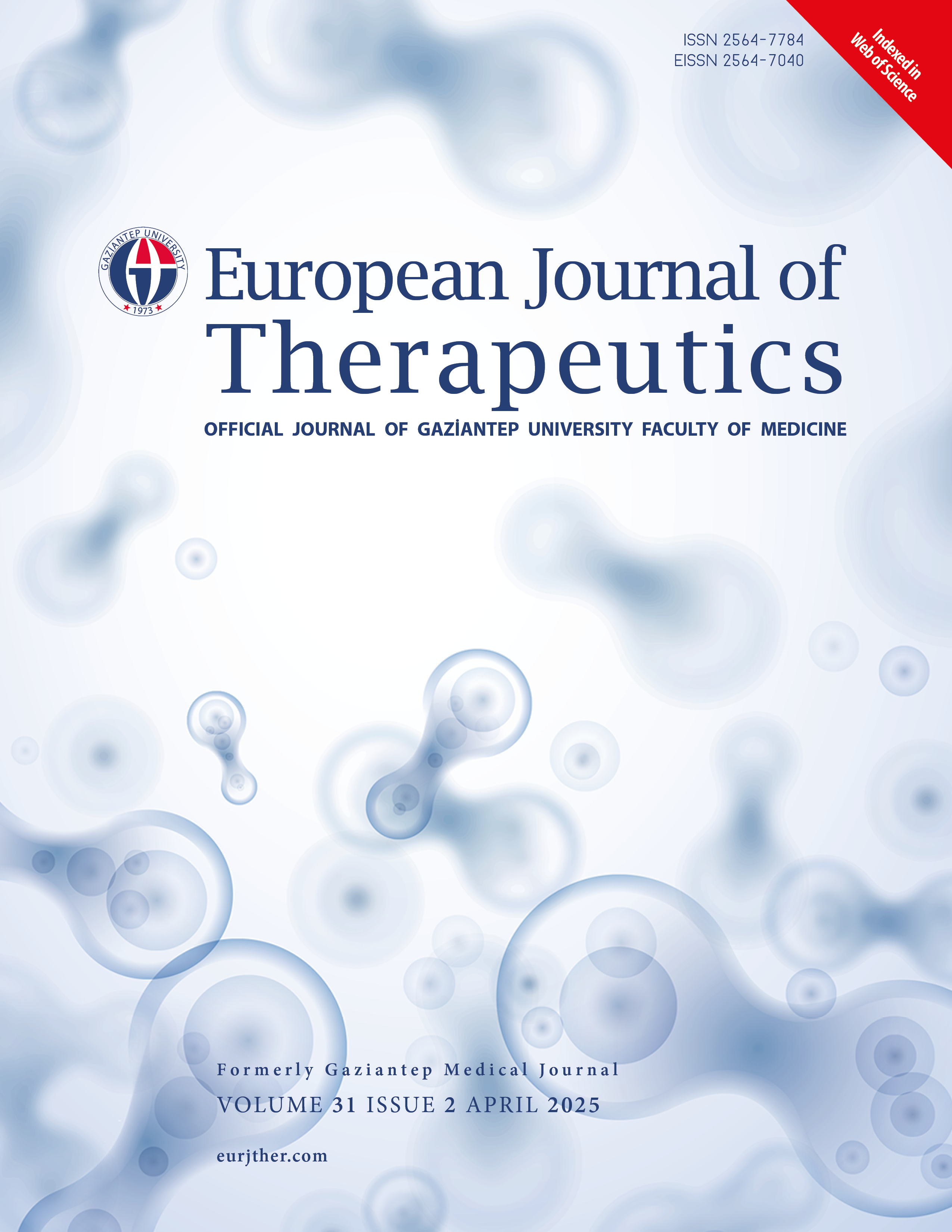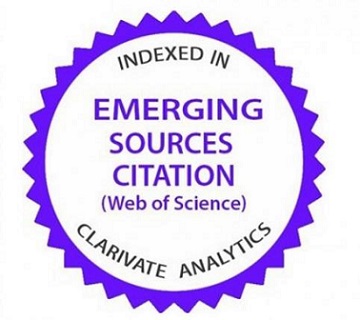Anaerobic Power and Sprint Performance in U19 Elite Football Players
DOI:
https://doi.org/10.58600/eurjther2653Keywords:
Anaerobic capacity, sprint speed, wingate protocol, football performance, young football playersAbstract
Objective: This study aimed to investigate the relationship between anaerobic power and sprint performance in U19 players of the Turkish Football Federation Elite Academy League.
Methods: A total of 23 male football players voluntarily participated in the study, with a mean age of 17.73±0.54 years, mean height of 174.18±6.58 cm, mean body weight of 67.99±6.30 kg, and mean body fat percentage of 22.38±1.01%. The Wingate Anaerobic Power and Capacity Test (WAnT) was used to assess anaerobic power and performance capacities, while 10m and 30m sprint tests were conducted to evaluate sprint speed performance.
Results: In the statistical analysis, variance homogeneity was tested using Levene’s Test, and normality distribution was assessed with the Shapiro-Wilk Test. Pearson correlation analysis was applied for all parameters. The results indicated a moderate negative correlation between anaerobic power (W) and the 10m sprint performance parameter (r = -0.45, p = 0.03), and a strong negative correlation with the 30m sprint parameter (r = -0.59, p = 0.01), both statistically significant.
Conclusion: The findings revealed a significant relationship between anaerobic power and sprint performance in Elite Academy League players. The direct influence of anaerobic power on the connection between these two parameters was also evident. Given that this age group represents the final stage of development in the league, systematically incorporating sprint speed training into the training regimen with appropriate periodization is recommended to enhance the players’ athletic performance and improve anaerobic power capacities.
Metrics
References
Moalla W, Fessi MS, Makni E, Dellal A, Filetti C, Di Salvo V, Chamari K. (2018). Association of physical and technical activities with partial match status in a soccer professional team. The Journal of Strength & Conditioning Research. 32(6):1708-1714. https://doi.org/10.1519/JSC.0000000000002033
Sæterbakken A, Haug V, Fransson D, Grendstad HN, Gundersen HS, Moe VF, Andersen V. (2019). Match running performance on three different competitive standards in Norwegian soccer. Sports medicine international open. 3(03):E82-E88. https://doi.org/10.1055/a-0943-3682
Wdowski MM, Gittoes MJ. (2021). Inter-limb step asymmetry in closed and open skill sprint accelerations in soccer players. Human Movement. 22(1):1-8. https://doi.org/10.5114/hm.2021.98458
Boraczyński M, Boraczyński T, Podstawski R, Wójcik Z, Gronek P. (2020). Relationships between measures of functional and isometric lower body strength, aerobic capacity, anaerobic power, sprint and countermovement jump performance in professional soccer players. Journal of Human Kinetics. 75:161. https://doi.org/10.2478/hukin-2020-0045
Colantonio E, Assis Neves TD, Winckler C, Fernandes Guerra RL (2020). Sport Training Effect in Female College Futsal Players on Aerobic and Anaerobic Performance. Journal of Exercise Physiology Online. 23(5).
Barnes C, Archer DT, Hogg B, Bush M, Bradley P. (2014). The evolution of physical and technical performance parameters in the English Premier League. International journal of sports medicine. 35(13):1095-1100. https://doi.org/10.1519/JSC.0000000000002033
Yasuda T, Ogasawara R, Sakamaki M, Ozaki H, Sato Y, Abe T. (2011). Combined effects of low-intensity blood flow restriction training and high-intensity resistance training on muscle strength and size. European journal of applied physiology. 111:2525-2533. https://doi.org/10.1007/s00421-011-1873-8
Peñailillo L, Espíldora F, Jannas-Vela S, Mujika I, Zbinden-Foncea H. (2016). Muscle strength and speed performance in youth soccer players. Journal of human kinetics. 50:203. https://doi.org/10.1515/hukin-2015-0157
Ruas CV, Pinto RS, Haff GG, Lima CD, Brown LE. (2019). Effects of different combinations of concentric and eccentric resistance training programs on traditional and alternative hamstrings-to-quadriceps ratios. Sports. 7(10):221. https://doi.org/10.3390/sports7100221
Oliver JL, Ramachandran AK, Singh U, Ramirez-Campillo R, Lloyd RS. (2024). The effects of strength, plyometric and combined training on strength, power and speed characteristics in high-level, highly trained male youth soccer players: a systematic review and meta-analysis. Sports Medicine. 54(3):623-643. https://doi.org/10.1007/s40279-023-01944-8
Pedersen S, Welde B, Sagelv EH, Heitmann KA, Randers MB, Johansen D, Pettersen SA. (2022). Associations between maximal strength, sprint, and jump height and match physical performance in high‐level female football players. Scandinavian Journal of Medicine & Science in Sports. 32(Suppl.1):54-61. https://doi.org/10.1111/sms.14009
Haugen TA, Tønnessen E, Seiler S. (2013). Anaerobic performance testing of professional soccer players 1995–2010. International journal of sports physiology and performance. 8(2):148-156. https://doi.org/10.1123/ijspp.8.2.148
Nikolaidis PT, Matos B, Clemente FM, Bezerra P, Camões M, Rosemann T, Knechtle B. (2018). Normative data of the wingate anaerobic test in 1 year age groups of male soccer players. Frontiers in physiology. 9:1619. https://doi.org/10.3389/fphys.2018.01619
Lupo C, Ungureanu AN, Varalda M, & Brustio PR. (2019). Running technique is more effective than soccer-specific training for improving the sprint and agility performances with ball possession of prepubescent soccer players. Biology of sport. 36(3):249-255. https://doi.org/10.5114/biolsport.2019.87046
Gardasevic J, Bjelica D, Vasiljevic I, Arifi F, Sermaxhaj S. (2019). Body composition of elite soccer players from Montenegro and Kosovo. Sport Mont. 17(3):27-31. https://doi.org/10.26773/smj.191011
Nobari H, Alves AR, Clemente FM, Pérez-Gómez J, Clark CC, Granacher U, Zouhal H. (2021). Associations between variations in accumulated workload and physiological variables in young male soccer players over the course of a season. Frontiers in physiology. 12:638180. https://doi.org/10.3389/fphys.2021.638180
Miller RM, Chambers TL, Burns SP, Godard MP. (2016). Validating InBody® 570 multi-frequency bioelectrical impedance analyzer versus DXA for body fat percentage analysis. Med Sci Sports Exerc. 48(5 Suppl 1):991.
Castagna C, Castellini E. (2013). Vertical jump performance in Italian male and female national team soccer players. The Journal of Strength & Conditioning Research. 27(4):1156-1161. https://doi.org/10.1519/JSC.0b013e3182610999
Newman MA, Tarpenning KM, Marino FE. (2004). Relationships between isokinetic knee strength, single-sprint performance, and repeated-sprint ability in football players. The Journal of Strength & Conditioning Research.18(4):867-872.
Özkan A, Köklü Y, Ersöz G. (2010). Wingate anaerobic power test. International Journal of Human Sciences. 7(1):209–211.
Cohen J. (1988). Statistical power analysis for the behavioral sciences. 2nd Lawrence Erlbaum Associates. Hillsdale, NJ.
Lockie RG, Schultz AB, Jeffriess MD, Callaghan SJ. (2012). The relationship between bilateral differences of knee flexor and extensor isokinetic strength and multi-directional speed. Isokinetics and exercise science. 20(3):211-219. https://doi.org/10.3233/IES-2012-0461
Bujnovsky D, Maly T, Ford KR, Sugimoto D, Kunzmann E, Hank M, Zahalka F. (2019). Physical fitness characteristics of high-level youth football players: Influence of playing position. Sports. 7(2):46. https://doi.org/10.3390/sports7020046
Pauole K, Madole K, Garhammer J, Lacourse M, Rozenek R. (2000). Reliability and validity of the T-test as a measure of agility, leg power, and leg speed in college-aged men and women. The Journal of Strength & Conditioning Research. 14(4):443-450.
Śliwowski R, Grygorowicz M, Wieczorek A, Jadczak Ł. (2018). The relationship between jumping performance, isokinetic strength and dynamic postural control in elite youth soccer players. J Sports Med Phys Fitness. 58(9):1226-33. https://doi.org/10.23736/S0022-4707.17.07289-9
Yanci Irigoyen J, Los Arcos Larumbe A. (2013). Aerobic and anaerobic performance variation in professional soccer players after preseason. Cultura_Ciencia_Deporte [CCD]. 8(24). https://doi.org/10.12800/ccd.v8i24.359
Masuda K, Kikuhara N, Demura S, Katsuta S, Yamanaka K. (2005). Relationship between muscle strength in various isokinetic movements and kick performance among soccer players. Journal of Sports Medicine and Physical Fitness. 45(1):44.
Al'Hazzaa HM, Almuzaini KS, Al-Refaee SA, Sulaiman MA. (2001). Aerobic and anaerobic power characteristics of Saudi elite soccer players. Journal of Sports Medicine and Physical Fitness. 41(1):54.
Aziz AR, Chuan TEH. (2004). Correlation between Tests of Running Repeated Sprint Ability and Anaerobic Capacity by Wingate Cycling in Multi-Sprint Sports Athletes. International Journal of Applied Sports Sciences. 16(1).
Oliva-Lozano JM, Gómez-Carmona CD, Pino-Ortega J, Moreno-Pérez V, Rodríguez-Pérez MA. (2020). Match and training high intensity activity-demands profile during a competitive mesocycle in youth elite soccer players. Journal of human kinetics. 75:195. https://doi.org/10.2478/hukin-2020-0050
Gabbett T. (2016) The training-injury prevention paradox: should athletes be training smarter or harder? Br J Sports Med. 50(5):273–280. https://doi.org/10.1136/bjsports-2015-095788
Markovic G, Mikulic P. (2010). Neuro-musculoskeletal and performance adaptations to lower-extremity plyometric training. Sports medicine. 40:859-895. https://doi.org/10.2165/11318370-000000000-00000
Adibpour N, Bakht HN, Behpour N. (2012). Comparison of the effect of plyometric and weight training programs on vertical jumps in female basketball players. World Journal of Sport Sciences. 7(2):99-104.
Carr C, McMahon JJ, Comfort P. (2015). Relationships between jump and sprint performance in first-class county cricketers. Journal of Trainology. 4(1):1-5. https://doi.org/10.17338/trainology.4.1_1
Şahin FN, Ceylan L, Küçük H, Ceylan T, Arıkan G, Yiğit S., Güler Ö. (2022). Examining the relationship between pes planus degree, balance and jump performances in athletes. International journal of environmental research and public health. 19(18):11602.
Cebi M, Ceviker A., Ozlu K, Elioz M, Yamak B, Kusan O, Ceylan L. (2021). Relationship between certain biochemical parameters and maximal aerobic speed of elite soccer players. Progress in Nutrition. 23(S1):1-15.
Sariakçali B, Ceylan L, Ceviker A. (2022). Evaluation of head trauma on pituitary function in professional soccer players. Acta Medica Mediterranea. 38(2):945-950.
Karadeniz S, Suveren C, Arslan Y, Ayyıldız Durhan T, Ceylan T, Albay F, Ceylan L. (2024). Examination of basic motor skills in children and adolescents. Frontiers in Physiology. 14:1346750.
Pamuk Ö, Makaracı Y, Ceylan L, Küçük H, Kızılet T, Ceylan T, Kaya E. (2023). Associations between force-time related single-leg counter movement jump variables, agility, and linear sprint in competitive youth male basketball players. Children. 10(3):427.
Haugen TA, Hellerud L, Tønnessen E. (2022). Sprinting demands and anaerobic capacity in professional football: Implications for strength and conditioning training. Journal of Sports Science & Medicine. 21(4):548-555. https://doi.org/10.1123/jssm.2022.0235
Silva RM, Silva AA, Barbosa JM. (2023). Anaerobic power and agility in football players: Implications for speed and match performance. Journal of Sports Performance. 12(1):27-34. https://doi.org/10.1007/s13105-023-0542-1
Marković G, Mikulić P. (2010). The role of lower-limb strength in sprint performance and its influence on anaerobic power. European Journal of Applied Physiology. 110(6):925-931. https://doi.org/10.1007/s00421-010-1620-0
Mendez-Villanueva A, Buchheit M, Simpson B, Bourdon P. (2008). Match running performance and fitness in youth soccer. International Journal of Sports Medicine. 29(5):395–400.
Downloads
Published
How to Cite
Issue
Section
License
Copyright (c) 2025 European Journal of Therapeutics

This work is licensed under a Creative Commons Attribution-NonCommercial 4.0 International License.
The content of this journal is licensed under a Creative Commons Attribution-NonCommercial 4.0 International License.


















